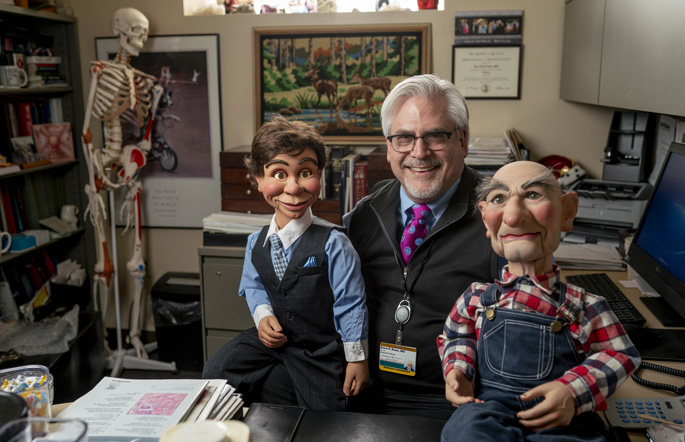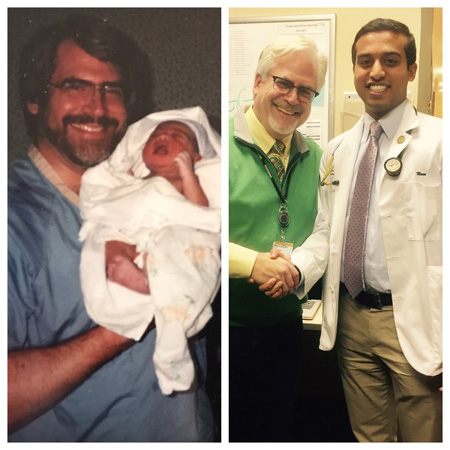
by Jill Clendening
When Bruce Beyer, MD, was a teenager, his grandmother stitched a needlepoint scene of a deer by a woodland stream that she gave him with explicit instructions to “hang it in his doctor’s office.”
“I wanted to be a vet at the time, but Nana had it in her mind that I was going to be a different kind of doctor,” Beyer laughed. “That beautiful needlepoint is above the cabinets in my office at One Hundred Oaks today, and it’s been in every office I’ve ever been in.”
Beyer, medical director of Vanderbilt Women’s Health at One Hundred Oaks, and associate professor of Clinical Obstetrics and Gynecology, credits several strong females throughout his life, including his grandmother, for influencing the trajectory of his career by focusing on caring for women.
“My mother was a grammar school teacher, and her devotion to her work was inspiring,” said Beyer. “I helped her prepare lessons and did artwork for her classroom. My older sister went into special education, so I come from a family of strong women who were teachers. I always felt that medicine offered a wonderful opportunity for me to teach on many different levels. As I got further into the field, it seemed like a natural fit.”
Beyer had two uncles who had attended Vanderbilt University, and during visits to Beyer’s family in New Jersey, they encouraged him to come to Vanderbilt for college.
“They both had great experiences at Vanderbilt,” Beyer said. “So, I came here with the intention of getting a pre-med undergraduate degree. I ended up majoring in psychology and minoring in teaching, which is not the typical pre-med pathway, but that’s what I did.”
Almost as soon as he arrived in Nashville, Beyer began volunteering at Vanderbilt University Adult Hospital. Every Saturday, from 8 a.m. until noon, he clocked in at the physical therapy unit to work with severely burned patients. Then, from 6 p.m. until midnight he wrapped up by volunteering in the emergency room.
Beyer earned his medical degree from Vanderbilt University in 1981, then completed his residency at Vanderbilt University Medical Center. He intended to become an orthopedic surgeon, but at one point, when he was a medical student, his supervising interns told him they saw him ending up in obstetrics/gynecology instead.
“I had no idea what they were talking about, but when I got to the OB-GYN rotation, I immediately felt it was where I was meant to be,” Beyer said. “I liked the idea of being specialized but also caring for patients during a natural life cycle process. It’s a lovely combination of surgery, medicine, psychology and teaching. I liked the energy, and I liked being able to use my communications skills.”
Throughout his early years of training and medical practice, Beyer took ample notes from physicians and nurses he considered mentors, and even the smallest gesture of support was appreciated. He still remembers one night working as an undergraduate in the emergency room when noted Vanderbilt cardiologist John Dixon, MD, stopped to chat with him.
“It was just one occasion, but it made a huge impact on me that he had taken the time to speak to me,” Beyer said. “I’ve run into him many times since then, and I’ve always reminded him of what he did.”
As for mentors within his specialty, Beyer points to maternal-fetal medicine icon Frank Boehm, MD, who will retire in May after 47 years on the Vanderbilt faculty, and former chair Howard Jones III, MD, whose gentle yet empowering guidance in the operating room was invaluable to Beyer and other residents. He also counts Lonnie Burnett, MD, who led the Department of Obstetrics and Gynecology for 19 years beginning in 1976, as a powerful influence. And he always enjoyed endless philosophical debates with Stephen Entman, MD, professor of Obstetrics and Gynecology, emeritus, who followed Burnett as chair.

It was during Beyer’s second year of residency that he first worked alongside midwives at General Hospital in Nashville, and he praises them for instructing him on essential delivery techniques. He became an early advocate of nurse-physician collaborations in providing patient care, adamantly supported incorporating advanced practice nurses in OB-GYN at Vanderbilt University School of Medicine and served as consulting physician to the Vanderbilt University School of Nursing midwifery practice for many years.
He was honored for his continued support with the 2017 Friend of Nursing Award presented by VUSN.
He told one story from early in his residency when he received the award.
“I was kind of green, and a transport patient came in,” he remembered. “Lisa Staggs was the nurse, and she looked at me and said, ‘Dr. Beyer, there’s a pre-term labor patient here; what would you like to do?’ I looked at her and I said, ‘Lisa, please do what you always do, and then teach me how you did it.’
“I’ve always appreciated the expertise of the nurses. Obviously, we all start off in a green zone, and we gain expertise. I think it’s so important to acknowledge that nurses at Vanderbilt do a lot of teaching and deliver a lot of excellent care.”
After Beyer completed his residency in 1985, he spent two years in private practice in nearby Hendersonville, Tennessee, working closely with Sally Yeagley, APN. Yeagley’s skill and knowledge further cemented his admiration and respect for nurses.
“I saw how important Sally was to the practice, and when I got recruited back to Vanderbilt, I made it clear that I wanted to have midwives involved in our practice,” Beyer said. “We had the great fortune of having Angela Wilson-Liverman join us. She’s now the head of the Division of Midwifery and Advanced Practice, and that’s now the largest division in our department.”
When he returned to VUMC in 1987, Beyer partnered with Doug Brown, MD, and Elizabeth “Libby” Oldfield, MD, to establish the Medical Arts Obstetrics and Gynecology practice, which was the institution’s first venture into a full-time medical practice staffed by full-time faculty. He also served as Obstetrics and Gynecology clerkship director for VUSM for three years before passing that program’s reins to colleague Charles Rush, MD.
In his role as medical director at Vanderbilt Women’s Health at One Hundred Oaks, Beyer provides preventive and well-woman care, as well as prenatal and postpartum care. He has fewer nights of interrupted sleep as he no longer delivers babies.
“I have patients now that I delivered, and I even had a medical student who rotated with me that I delivered,” Beyer said. “That makes me feel a little old, but I’m very honored. It’s lovely to see patients year after year and to get to know their families. Some patients send me pictures of their children on their birthdays, and it’s just so gratifying.”
Beyer’s also been thrilled to watch the Department of Obstetrics and Gynecology flourish over the three decades he’s been with the group, with prenatal care and delivery services now provided to more than 4,500 women annually, and nearly 500 women transported to VUMC to receive tertiary, high-risk labor and delivery care each year.
“Dr. Jones and Dr. Boehm were important leaders in that growth and success,” Beyer said. “Dr. Ron Alvarez has been wonderful as our new chairman, and he’s really continuing that growth curve.”
While his patients and Medical Center colleagues probably feel they know the affable Beyer well, they might be surprised to learn about his major hobby, collecting and operating ventriloquist figures. (He promised he won’t be offended if you call them dummies, but technically, they’re known as figures.)
“In 1980, when I was nearing graduation from medical school, my parents wanted to get me a gift,” he said. “I said, ‘That’s simple, I want a professional ventriloquist figure.’”
He got the figure and began taking a mail order course on how to operate the figure from Maher Studios, then run by famed ventriloquist Clinton Detweiler. He honed his skills and performed a short routine for his fellow medical students.
His devotion to the hobby has never faltered, and he now owns 20 wood-carved figures as well as a few soft puppets. For several years he owned a figure named Woodrow crafted by master sculptor Alan Semok that was featured in the 2003 movie “Dummy,” starring Adrien Brody. Beyer later donated Woodrow to the Vent Haven Museum, a ventriloquism museum in Fort Mitchell, Kentucky, in honor of his parents.
He’s developed close friendships with Semok and another famous figure maker, Tim Selberg, and speaks to them at least once a week about their shared loved of the figures and the craft of ventriloquism.
When he’s not hanging out with dummies, um, figures, Beyer enjoys listening to his wife, singer-songwriter Stacy Beyer, sing her new music. Stacy began her career in country music, and she co-wrote a popular song for Tracy Byrd in 1998 called “Back to Texas” and had a No. 1 hit in Australia called “Dancing with Elvis.” Now, she writes original Jewish music, and her songs are performed by congregations throughout the United States.












